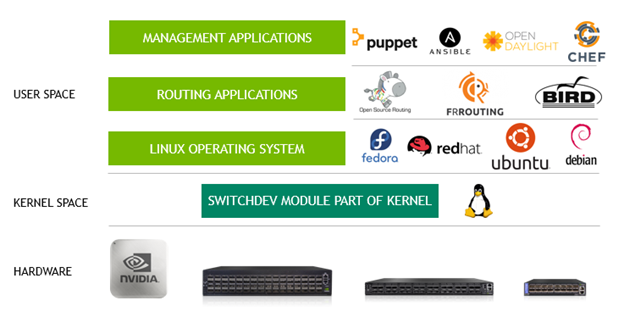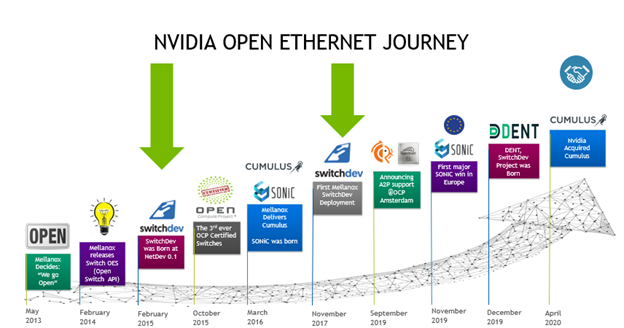Picture this: you’re having dinner at an upscale restaurant. You look at the menu and decide that you’re in the mood for a filet. You order the steak medium rare. The waiter brings it out, it’s plated beautifully, and the service is great. Yet you hear a little voice in the back of your head. “I could have prepared this steak in my own kitchen exactly to my definition of medium rare!”
We’ve all had that feeling: to get that perfect outcome, sometimes you’ve got to put in some of the work yourself. Yandex recognized this, and that is why they have partnered with NVIDIA to use NVIDIA Linux Switch on NVIDIA Spectrum Ethernet switches. NVIDIA is uniquely positioned to enable and support pioneers like Yandex while they grow the open networking ecosystem.
Yandex is a Russian internet company. You could describe Yandex as a search engine much like Google, but they do much more than just search. Yandex provides many services to users: music and movie streaming, translation, intelligent personal assistants, and more.
As Anton Kortunov, networking lead at Yandex, explains, “Yandex has several data centers, with each data center containing tens or even hundreds of thousands of servers connected by thousands of switches. Managing this infrastructure is no small task.”
Yandex employs cloud operational models to make the deployment, administration, and automation of the data center as efficient and seamless as possible, at as low a cost as possible.
Technological considerations
In addition to the general requirements of cloud-scale efficiency and economy, Yandex had some key needs that had to be met by any networking solution they went with:
- Their data centers make extensive use of IPv6; in particular, BGP sessions inside the fabric on IPv6 link-local addresses.
- QoS and ACL tools were needed, and any networking stack had to integrate with telemetry, monitoring, and automation tools.
- A network switch infrastructure that supported extensive ZTP, or zero touch provisioning. In particular, the ZTP needed to tie into the monitoring tools, to verify deployment and bring-up success at scale.
Looking at their requirements, Yandex evaluated several options. To do the desired integration and automation, Yandex determined they needed a truly open-source NOS. SONiC was considered but had too many limitations around IPv6 addressing. Enter NVIDIA Linux Switch.
What is Linux Switch?
NVIDIA Linux Switch allows customers to run any Linux distribution as the network operating system on Spectrum Ethernet switches. The secret sauce for Linux Switch is Switchdev, a Linux kernel driver model that Linux Switch is based on.
Much like in the server operating system case, Linux Switch is built for independence. Rather than using proprietary APIs, fully standard Linux kernel interfaces are used to control the switch silicon. This allows the switch and Linux distribution choice to be completely independent, with the switch hardware doing the heavy lifting through offloading.

Linux Switch brings several key benefits to Yandex. As mentioned earlier, Yandex had some key technological requirements that had to be met with any networking OS. Linux Switch provides Yandex the flexibility to customize and optimize the switch to their exact needs, with no extra features driving up cost.
The transparency of Linux Switch and the Linux operating model also allows Yandex full visibility into the distribution, greatly simplifying troubleshooting and debugging. This enabled Yandex to integrate their networking infrastructure with tooling built in-house for automation and configuration management.
By combining the Linux Switch implementation with these custom tools, Yandex had complete control over the feature set without having to build an operating system from scratch.
Why NVIDIA?
As part of the Linux kernel, there is nothing that restricts Switchdev to the NVIDIA Spectrum Ethernet platform. What makes NVIDIA Linux Switch the right choice?
The answer is that the hardware matters. The NVIDIA software-defined, hardware-accelerated approach makes Spectrum a uniquely suitable fit for Switchdev. With each new ASIC and platform, Switchdev support and compatibility is one of the first considerations in the design stage, and every NVIDIA switch platform supports Linux Switch.
In addition, the breadth of switch port speeds (from 1 to 400G) and switch form factors (1/2U, as well as half-wide) enables the Spectrum portfolio to meet any data center networking need, Switchdev or otherwise.
Complementing the optimized hardware portfolio, NVIDIA is a key member of the open-source networking ecosystem. NVIDIA works with the open-source community to support and triage customer issues. Linux Switch optimizations made by NVIDIA engineering are upstreamed as part of all major Linux distributions.
With Linux Switch on Spectrum, Yandex gained transparency and control over the network, and disaggregated networking hardware and software, and lowered costs. As Kortunov puts it, “We met our overall goal of letting whitebox switches act like vendor boxes.” Yandex got all the positives of proprietary vendor solutions without all the associated negative baggage that comes along with proprietary lock-in.
To learn more about Yandex and their networking journey with NVIDIA, see the joint session as part of GTC. From November 8-11, GTC features hundreds of sessions packed with interesting insights and discoveries from NVIDIA customers and partners.
To attend the session with Anton Kortunov and David Iles, register for GTC. The Yandex session will be live on November 11 at 9 AM CET and will be available on-demand afterwards. Enjoy!











